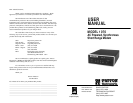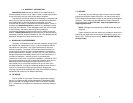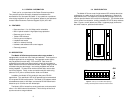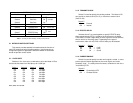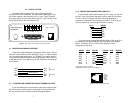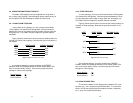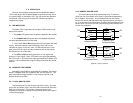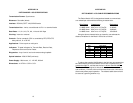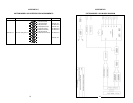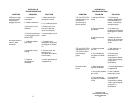
Table 1. Summary of switch settings, showing factory defaults
3.1 DETAILED SWITCH SETTINGS
This section provides detailed information about the function of
each DIP switch and lists all possible settings. Use this section as
configuration guide for applications where the Model 1070's default
would not provide correct results.
3.1.1 DATA RATE
Switches 1 thru 3 are set in combination to allow the Model 1070 to
be used at data rates from 1200 bps up to 19,200 bps.
Switch 1 Switch 2 Switch 3 Setting
On On On 1.2 Kbps
Off On On 2.4 Kbps
On Off On 4.8 Kbps
On On Off 7.2 Kbps
Off Off On 9.6 Kbps
Off On Off 14.4 Kbps
On Off Off 19.2 Kbps
Off Off Off 19.2 Kbps
Note: Switch 4 is not used.
5
SWITCH SUMMARY TABLE
Position Function Factory Default
Switch 1 Data Rate Off
Switch 2 Data Rate Off
Switch 3 Data Rate On
Switch 4 Not Used N/A
Switch 5 Transmit Clock Off
Internal Clock
Switch 6 RTS/CTS Delay On
Switch 7 RTS/CTS Delay Off
Switch 8 Carrier Control Off
Constant
8 ms
9,600 Bps
}
}
3.1.2 TRANSMIT CLOCK
Switch 5 is used to specify the clocking method. The Model 1070
can provide an internal clock (Pin 15), or receive an external clock
(from Pin 24).
Switch 5
On = External
Off = Internal
3.1.3 RTS/CTS DELAY
Switches 6 and 7 are used together to specify RTS/CTS delay.
After request to send (RTS) is raised by the host terminal, the Model
1070 raises CTS after a slight delay in order to give the remote terminal
time to receive an incoming signal. Depending on the type of
environment, either a 0 mS, 8 mS or 53 mS delay can be selected.
Switch 6 Switch 7
On On = 0 mS
On Off = 8 mS
Off On = 53 mS
3.1.4 CARRIER ENABLE
Switch 8 is used to specify how the carrier signal is raised. In most
point-to-point full duplex applications, the carrier signal can remain
constantly "high". In a multi-point environment, contention for the line is
"controlled" by RTS.
Switch 8
On = Controlled by RTS
Off = Constant Carrier
6



